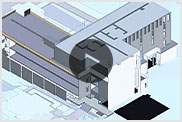

If a user wants to see what a planned room would look like with another window, for example, the change can be made in Revit and team members can immediately see those changes in Unity Reflect. One of the most groundbreaking features is the ability for real-time collaboration between both platforms. “This is beyond interoperability,” says Tim McDonough, the GM of Industrial for Unity, “we’re hoping to unlock the power of BIM.” While a critical goal of the integration was to make the tools work together with minimal effort required, Reflect hopes to act as more than just a bridge. Unity’s goal with Reflect was to make these types of data viewable for anybody with any device, and collaborators won’t need to be in the same room or on the same device to make real-time changes. Users can take advantage of the power of Revit for design, pairing it with Unity’s broad compatibility that includes mobile, tablet, and VR/AR platforms. The tool allows Revit users to export files directly into Unity (and vice versa).

Working closely with Autodesk on this effort has helped Unity to ensure that they bring Revit and BIM data through with the best possible fidelity. When users want to share their work with a team, they can now do so with both high accuracy and broad device compatibility.

The result of a months-long collaboration between Autodesk and Unity, Reflect was debuted at the 2019 American Institute of Architects conference in June.Ĭonnecting Unity’s powerful viewing software with Revit with only a few clicks, Reflect could be a game-changer for Revit power users. The new product, named Reflect, allows users to seamlessly import BIM and CAD data and create a single, interactive rendering that is accessible on a variety of devices. Unity Technologies, primarily known for their 3D development and gaming platforms, has introduced its first AEC-focused product with a real-time 3D viewer that integrates with Autodesk Revit.


 0 kommentar(er)
0 kommentar(er)
